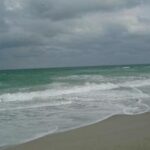As a native of Southeast Asia the Bala shark (Balantiocheilos melanopterus) is typically found among the freshwater rivers and lakes of the Mekong and Chao Phraya River Basins. They are also known to frequent the Malay Peninsula, as well as various rivers and lakes in Sumatra and Bornea. In recent years several factors including the destruction of their natural habitat, overfishing, and environmental pollution have caused the Bala Shark to become extremely rare and even reportedly extinct in some of these wild habitats specifically the Danau Sentarum in Borneo and the Batang Hari Basin in Sumatra. Captive breeding programs in Indonesia and Thailand have been supplying the aquarium fish trade with a significant portion of the Bala shark population.
The Bala shark also referred to as the Tricolor shark, Silver shark, Shark minnow, and Silver Bala is not a true shark at all but has earned this label because of the sleek, torpedo shaped body and large triangular shaped fin that is often associated with the shark species. The Bala shark belongs to a group of bony fish that fall under the Class Actinopterygii, Order Cypriniformes and Family Cyprinidae which happen to include carps, minnows, barbs, and danios. In fact the Bala shark is classified as a minnow.
The Bala shark can reach a maximum length of up to 14 to 16 inches. The males are larger than the females though females can be distinguished by a larger, rounder stomach. The body of the Bala shark is silver in color with black edges along the dorsal, caudal, anal, and pelvic fins. In some cases there is a yellow line that runs between the black edges and silver of the Bala shark.
Their body is very slender and convex in shape. They have large eyes used for detecting and pursuing prey. The Bala shark’s dorsal fin is triangular and the tail has a well-defined, sharp side-ways V-shape to it. It has a downward facing mouth void of extensions referred to as barbs seen in other species related to this family of fish.
The Bala shark is a scavenging omnivore. Though it typically hunts its food it will also scavenge for left-overs from the bottom of the tank. Their natural food source includes phytoplankton, small crustaceans, rotifers, insects, and insect larvae. Bala sharks are not finicky eaters and will consume just about anything you feed them. It is highly recommended that they be provided with a balanced diet that includes pellets, flakes, and live food consisting of meat and vegetable material. They also excel in maintaining algal growth in aquariums.
Although Bala sharks are very docile and peaceful fish they are known to eat those creatures that are small enough to fit into their mouth including brine shrimp, ghost shrimp, guppies, and even tetras. They are large and swift allowing them the ability to escape the attempts of more aggressive fish. Ideal tank mates include Angel fish, gouramis, barbs, Rainbow fish, Spiny eels, danios, and Clown loaches. Avoid placing the territorial Red tailed black shark or the aggressive African cichlids in with the Bala shark.
Bala sharks can survive alone but it is best to keep them in groups of 3 to 5 or more due to their schooling nature. When kept in an aquarium that is too small or as a lone fish the Bala shark may exhibit more aggressive behavior that will be directed at other creatures within the tank. For this reason it is important to maintain an adequate sized tank and provide other Bala sharks for companionship.
The Bala shark is sexually mature when it reaches between 10 and 15 centimeters in length. Using external fertilization to breed the Bala shark will not guard the eggs or fry after the breeding process and, in fact, have been known to eat their own eggs and fry. If you intend on breeding your Bala sharks make certain to place the young into another tank so that they may grow safely.
The tank environment should include live or plastic plants, driftwood, and rocks to simulate their natural environment. Being an active schooling fish they will also require a large open area for swimming. A 75 -125 gallon tank (approximately 72″L X 24″W X 17″H) is recommended with 75″ L being the absolute minimum suggested. Bala sharks are excellent jumpers so a top should be secured to the tank to avoid any unfortunate mishaps, especially since the Bala shark is rather skittish and timid.
Bala sharks are a relatively hardy fish species and can tolerate some changes to their environment involving temperature, pH levels, etc. However, the ideal pH levels are between 5.8 and 8.0 which are slightly alkaline. A water hardness of soft to medium (5.0 – 15.0 dGH) is preferred. The temperature of the water in the tank should be between 72 and 84 degrees Fahrenheit (22 – 29 degrees Celsius).
Bala sharks are beautiful creatures and when provided with adequate conditions and proper care make wonderful additions to an aquatic environment. Doing the proper amount of research on this particular species will aid you in providing an ideal home for this amazing creature. Speak with exotic veterinarians in your area who specialize in caring for the Bala shark to find the right fit for you.
Sources:
http://www.aquaticcommunity.com/sharkfish/balashark.php
http://en.wikipedia.org/wiki/Bala_shark
http://www.wisegeek.com/what-is-a-bala-shark.htm
http://www.suite101.com/article.cfm/tropical_fish/104579
http://www.learnanimals.com/bala-shark/
http://www.fishlore.com/Profiles-BalaShark.htm

